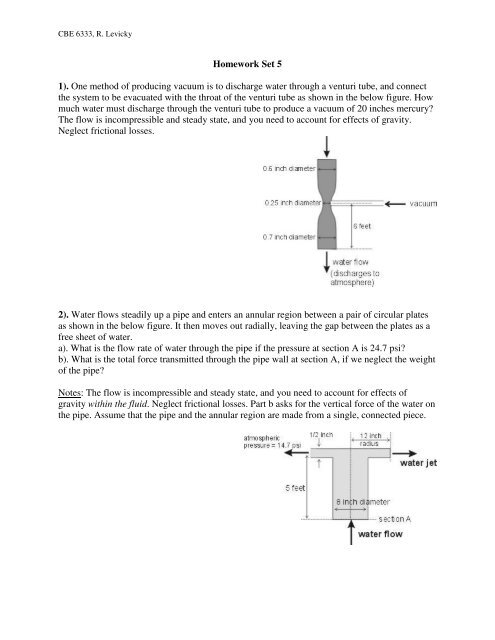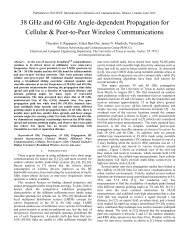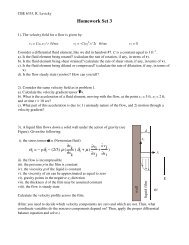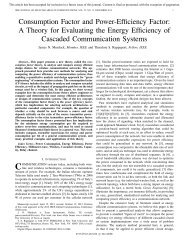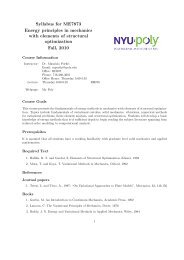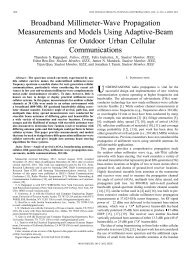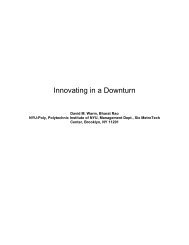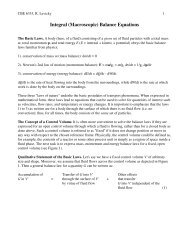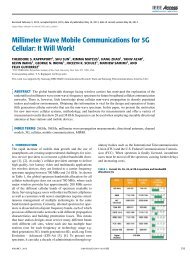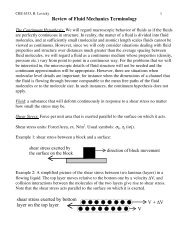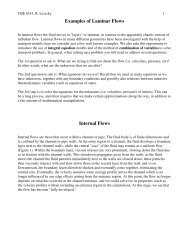Homework Set 5 1). One method of producing vacuum is to ...
Homework Set 5 1). One method of producing vacuum is to ...
Homework Set 5 1). One method of producing vacuum is to ...
Create successful ePaper yourself
Turn your PDF publications into a flip-book with our unique Google optimized e-Paper software.
CBE 6333, R. Levicky<strong>Homework</strong> <strong>Set</strong> 51). <strong>One</strong> <strong>method</strong> <strong>of</strong> <strong>producing</strong> <strong>vacuum</strong> <strong>is</strong> <strong>to</strong> d<strong>is</strong>charge water through a venturi tube, and connectthe system <strong>to</strong> be evacuated with the throat <strong>of</strong> the venturi tube as shown in the below figure. Howmuch water must d<strong>is</strong>charge through the venturi tube <strong>to</strong> produce a <strong>vacuum</strong> <strong>of</strong> 20 inches mercury?The flow <strong>is</strong> incompressible and steady state, and you need <strong>to</strong> account for effects <strong>of</strong> gravity.Neglect frictional losses.2). Water flows steadily up a pipe and enters an annular region between a pair <strong>of</strong> circular platesas shown in the below figure. It then moves out radially, leaving the gap between the plates as afree sheet <strong>of</strong> water.a). What <strong>is</strong> the flow rate <strong>of</strong> water through the pipe if the pressure at section A <strong>is</strong> 24.7 psi?b). What <strong>is</strong> the <strong>to</strong>tal force transmitted through the pipe wall at section A, if we neglect the weight<strong>of</strong> the pipe?Notes: The flow <strong>is</strong> incompressible and steady state, and you need <strong>to</strong> account for effects <strong>of</strong>gravity within the fluid. Neglect frictional losses. Part b asks for the vertical force <strong>of</strong> the water onthe pipe. Assume that the pipe and the annular region are made from a single, connected piece.
CBE 6333, R. Levicky3). The stream function <strong>of</strong> an incompressible, two-dimensional flow <strong>is</strong>ψ = x 1 2 + x 22Does th<strong>is</strong> flow have a velocity potential?4). A potential vortex <strong>is</strong> located near an infinite plane at a d<strong>is</strong>tance h above the plane (see figurebelow). The pressure at infinity <strong>is</strong> p o where the velocity <strong>is</strong> V o parallel <strong>to</strong> the plane. The strength<strong>of</strong> the vortex <strong>is</strong> Γ. The fluid <strong>is</strong> incompressible and inv<strong>is</strong>cid (ie. frictionless).Find the <strong>to</strong>tal force, per unit width <strong>of</strong> the plane in<strong>to</strong> the page, exerted on the plane if the pressureon the back side <strong>of</strong> the plane <strong>is</strong> p o .5). The following expression has been proposed for the velocity in turbulent pipe flow in the coreregion, outside the laminar sublayer:v=⎛ 3.5ln⎜ x⎝ 21+( r / R)1+2( r / R)⎞⎟⎠**122+2a). Show that the above expression follows from the conservation <strong>of</strong> momentum law and thefollowing expression for the eddy v<strong>is</strong>cosity ε5.5ε⎟ ⎜⎛ * ⎛ r ⎞ rCx2 ⎜1+ 1 + 2( µ / ρ)⎝ R ⎠⎝R=22⎞⎟⎠εif you assume that >> 1. You may want <strong>to</strong> start the problem by working "backwards",( µ / ρ)*using the expression for v1 .b). Show that the above expression for*v1 sat<strong>is</strong>fies the symmetry condition on velocity at r = 0.


